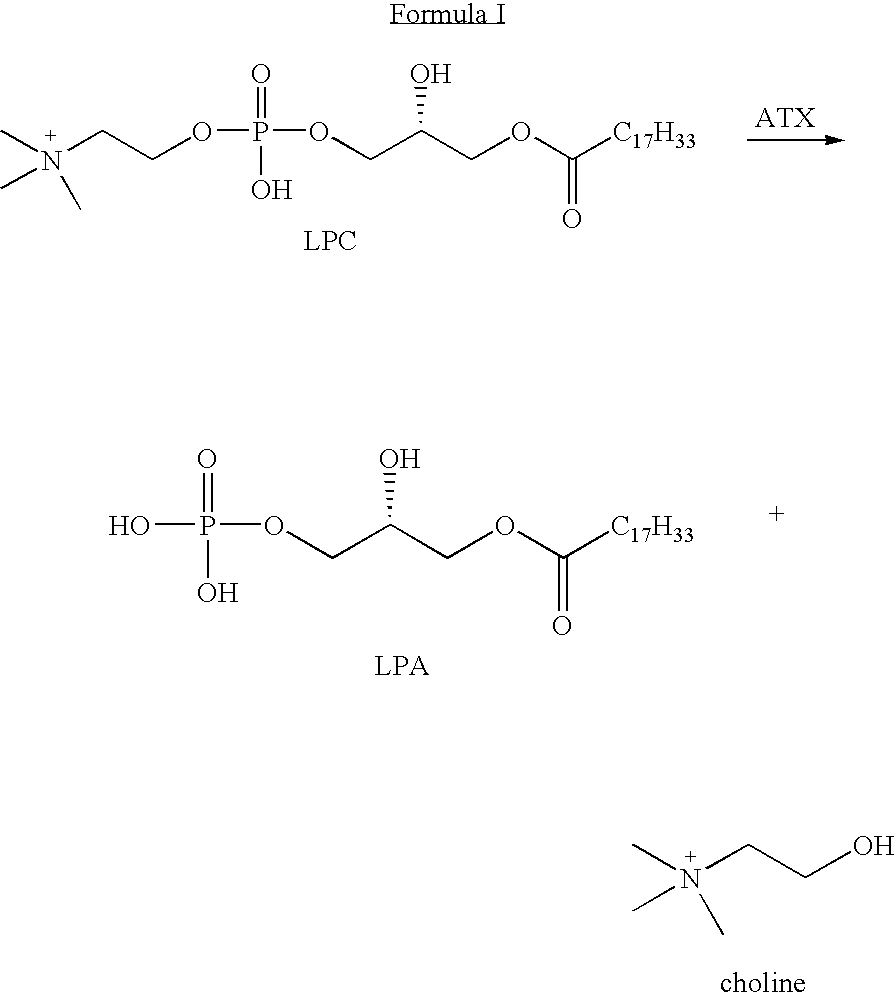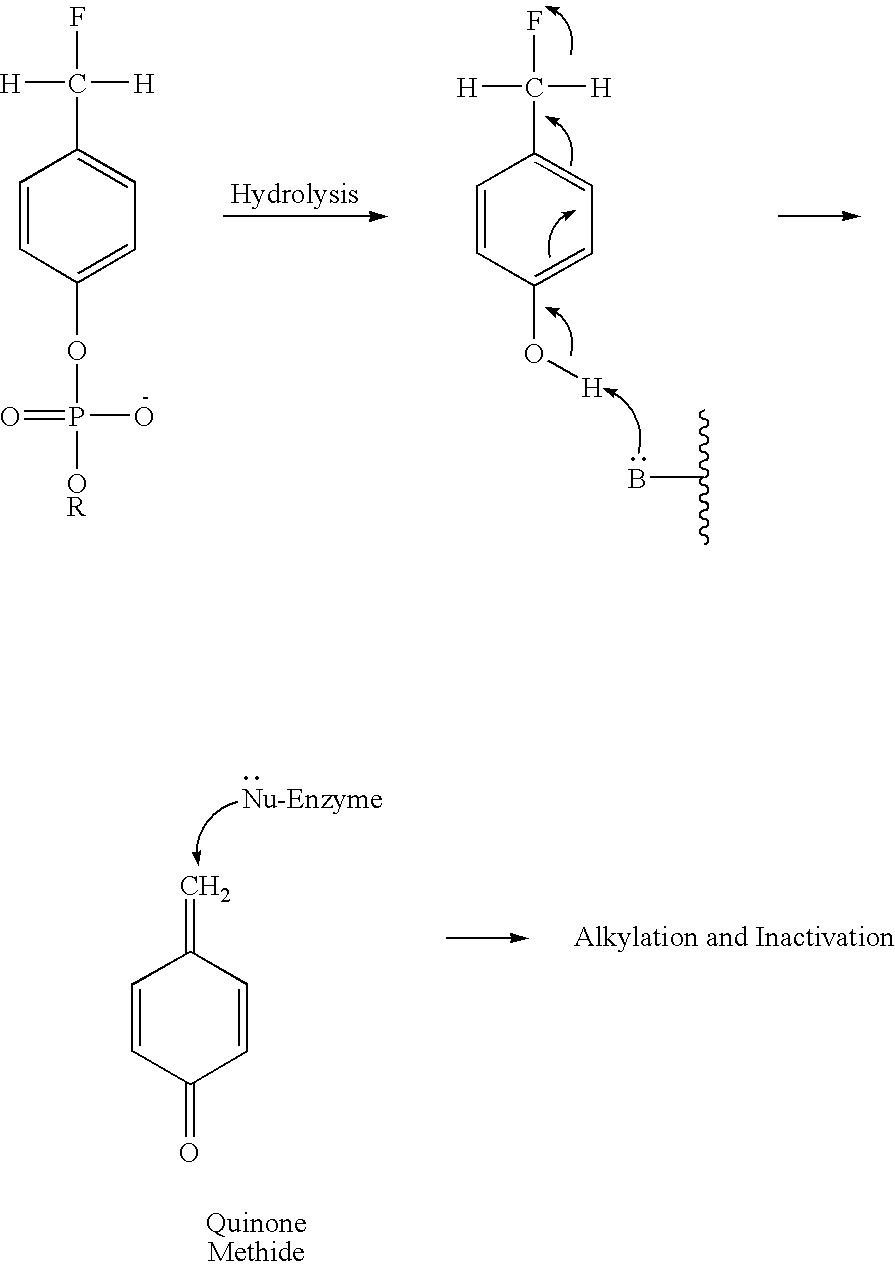Mechanism-based inactivators of autotaxin
a technology of inactivators and motors, applied in chemical treatment enzyme inactivation, enzymology, organic compounds of group 5/15 elements, etc., can solve the problems of inability to achieve actual results, inability to achieve cancerous growths, and inability to further process into bioactive forms and potentially dangerous, so as to reduce the conversion of lpc to lpa, reduce the activity of autotaxin, and easy to produce
- Summary
- Abstract
- Description
- Claims
- Application Information
AI Technical Summary
Benefits of technology
Problems solved by technology
Method used
Image
Examples
example 1
(18:0)-p-difluorophosphodiester
[0030]
[0031]Phosphorous oxychloride (1 eq.) was added to a round bottom flask and dissolved in tetrahydrofuran (THF). The round bottom flask was then placed in an ice bath to maintain a 0° C. temperature. Octadecanol (1 eq.) dissolved in THF with triethylamine (TEA) (1 eq.) was added dropwise to the phosphorous oxychloride / THF solution. Once all of the octadecanol / THF / TEA solution was added (˜20 min.), the reaction mixture was stirred for an additional 40 minutes at 0° C. A solution of p-hydroxybenzaldehyde (1 eq.) in THF with TEA (1 eq.) was added dropwise to the reaction flask and was stirred for an additional 40 minutes at 0° C. Water (1 eq.) and TEA (1 eq.) were added to the reaction mixture which was allowed to stir for 60 minutes at 0° C. The contents of the reaction flask were then vacuum filtered and dried in vacuo. After an extraction with chloroform / methanol / water 1:1.5:1 (v / v / v), the (18:0)-p-phosphodiester was dissolved in 40% ethyl acetate...
example 2
(18:0)-p-monofluorophosphodiester
[0035]
[0036]Phosphorous oxychloride (1 eq.) was added to a round bottom flask and dissolved in tetrahydrofuran (THF). The round bottom flask was then placed in an ice bath to maintain a 0° C. temperature. Octadecanol (1 eq.) dissolved in THF with triethylamine (TEA) (1 eq.) was added dropwise to the phosphorous oxychloride / THF solution. Once all of the octadecanol / THF / TEA solution was added (˜20 min.), the reaction mixture was stirred for an additional 40 minutes at 0° C. A solution of p-hydroxybenzaldehyde (1 eq.) in THF with TEA (1 eq.) was added dropwise to the reaction flask and was stirred for an additional 40 minutes at 0° C. Water (1 eq.) and TEA (1 eq.) were added to the reaction mixture which was allowed to stir for 60 minutes at 0° C. The contents of the reaction flask were then vacuum filtered and dried in vacuo. After an extraction with chloroform / methanol / water 1:1.5:1 (v / v / v), the (18:0)-p-phosphodiester was dissolved in 40% ethyl aceta...
example 3
(16:0)-p-difluorophosphodiester
[0040]
[0041]Phosphorous oxychloride (1 eq.) was added to a round bottom flask and dissolved in tetrahydrofuran (THF). The round bottom flask was then placed in an ice bath to maintain a 0° C. temperature. Hexadecanol (1 eq.) dissolved in THF with triethylamine (TEA) (1 eq.) was added dropwise to the phosphorous oxychloride / THF solution. Once all of the hexadecanol / THF / TEA solution was added (˜20 minutes), the reaction mixture was stirred for an additional 40 minutes at 0° C. A solution of p-hydroxybenzaldehyde (1 eq.) in THF with TEA (1 eq.) was added dropwise to the reaction flask and was stirred for an additional 40 minutes at 0° C. Water (1 eq.) and TEA (1 eq.) were added to the reaction mixture which was allowed to stir for 60 minutes at 0° C. The contents of the reaction flask were then vacuum filtered and dried in vacuo. After an extraction with chloroform / methanol / water 1:1.5:1 (v / v / v), the (16:0)-p-phosphodiester was dissolved in 40% ethyl acet...
PUM
| Property | Measurement | Unit |
|---|---|---|
| temperature | aaaaa | aaaaa |
| pH | aaaaa | aaaaa |
| emission wavelengths | aaaaa | aaaaa |
Abstract
Description
Claims
Application Information
 Login to View More
Login to View More - R&D
- Intellectual Property
- Life Sciences
- Materials
- Tech Scout
- Unparalleled Data Quality
- Higher Quality Content
- 60% Fewer Hallucinations
Browse by: Latest US Patents, China's latest patents, Technical Efficacy Thesaurus, Application Domain, Technology Topic, Popular Technical Reports.
© 2025 PatSnap. All rights reserved.Legal|Privacy policy|Modern Slavery Act Transparency Statement|Sitemap|About US| Contact US: help@patsnap.com



